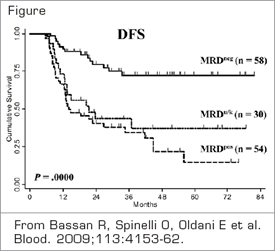ALL is a great success story for pediatric hematology. So effective is the treatment of childhood ALL that protocols are actually examining reducing therapy for selected subgroups. Meanwhile, in the adult world gains are incremental. Most adult ALL patients will go into a complete remission (CR), but most will relapse. Once relapse occurs, the chance of long-term survival with chemotherapy is minute.
Transplantation is an attractive option for ALL. Curiously, results in CR1 or CR2 are fairly similar, unlike in AML. One strategy for adult ALL may be to avoid transplant in CR1, and if/when relapse occurs, re-induce into CR2 and then transplant. The problem is that many patients will never get to CR2, or, if they do, they may not get to a transplant before relapse inevitably occurs. This is especially a problem if the search for an unrelated donor is not initiated until the time of CR2.
Table. Outcomes Depending on Donor Status
| Outcome . | Donor . | No donor . | Hazard ratio (95% C.I.) . |
|---|---|---|---|
| DFS | 60% | 42% | 0.60 (0.41-0.89) |
| Relapse | 24% | 55% | 0.37 (0.23-0.60) |
| Non-Relapse Mortality (NRM) | 16% | 3% | 4.84 (1.60-14.6) |
| Survival | 61% | 47% | 0.70 (0.46-1.05) |
| Outcome . | Donor . | No donor . | Hazard ratio (95% C.I.) . |
|---|---|---|---|
| DFS | 60% | 42% | 0.60 (0.41-0.89) |
| Relapse | 24% | 55% | 0.37 (0.23-0.60) |
| Non-Relapse Mortality (NRM) | 16% | 3% | 4.84 (1.60-14.6) |
| Survival | 61% | 47% | 0.70 (0.46-1.05) |
Adapted from Cornelissen JJ, van der Holt B, Verhoef GE et al. Blood. 2009;113:1375-82.
Should we transplant every possible case in CR1? Earlier data suggested that the benefit was only in those cases defined as high-risk ALL.1 However, a more recent study, using a rigid intent-to-treat statistical approach, suggested that allogeneic transplantation was superior to non-transplant options, even in standard-risk ALL.2 However, this study has met with some skepticism, if for no other reason than it challenged the status quo.
The study by Cornelissen et al., from the Dutch-Belgian Cooperative Trial Group HOVON, might provide the tiebreaker. They studied 288 adult patients, classified as either donor available (matched related donor ready and willing) or not. Outcomes were calculated starting from the time of remission. Remarkably, of the 96 patients in the donor available group, 91 (95 percent) received an allogeneic transplant. In the other group (N=161), 79 percent received an autologous transplant, and 19 percent received an unrelated or related-mismatched transplant. The data (see Table) showed a distinct difference in outcomes. Importantly, the survival benefit in the donor group (presumably from allogeneic transplantation) was significant in both standard and high-risk disease.
From Bassan R, Spinelli O, Oldani E et al. Blood. 2009;113:4153-62.
From Bassan R, Spinelli O, Oldani E et al. Blood. 2009;113:4153-62.
Another paper adds more to the story. Bassan et al. used minimal residual disease (MRD) to risk-stratify patients. MRD-negative patients were defined by PCR test showing evidence of absence of IgH gene rearrangements and were treated with maintenance therapy while all others received more aggressive therapy, including allogeneic transplantation. The results were striking (see Figure). Those with MRD-negative had a >70 percent disease-free survival on maintenance therapy alone. Those patients with MRD did poorly, regardless of therapy type. These results are not surprising given the pediatric data on MRD and outcome and previous results that patients with MRD at the time of transplant do relatively poorly compared to those who are in CR and without detectable MRD. The work clearly shows the power of MRD detection in predicting relapse.
In Brief
With apologies to The Bard of Stratford, the question in ALL may not be to transplant or not to transplant, but rather who and when? Should all ALL cases in CR1 be transplanted? Or should those in CR, with MRD, be offered transplant, while those without MRD spared transplant and offered maintenance therapy? Additional study is urged to further refine which patients should undergo a transplant at CR, depending on MRD status, and how to integrate pre-treatment studies (e.g., prognostic genes taken from gene expression studies). Given the success of URD compared to related stem cell transplant, these studies should include strategies to use MRD status to launch timely alternative donor transplants.
References
Competing Interests
Dr. Radich indicated no relevant conflicts of interest.

